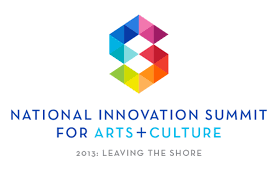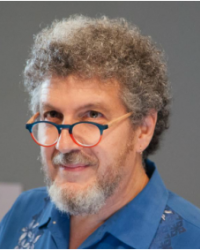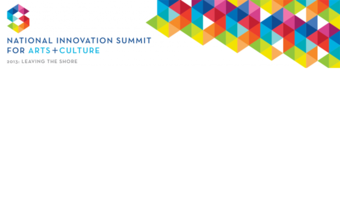In Pursuit of Business Unusual & The National Innovation Summit
This is the first of three pieces related to the upcoming National Innovation Summit for Arts & Culture. Karina is the Director of Activating Innovation at EmcArts Inc.
For six years before I joined the staff of EmcArts, I cut my professional teeth as an administrator in the New York City theatre community working for 13P, the Public, Miller Theatre, and eventually, finding a home for three years as the General Manager at HERE.
I learned the ropes along the way, picking up best practices in budgeting, wrangling artists, contracting, union issues, and all the stuff you learn on the fly because you have to. At HERE especially, I recall that there was a long legacy of how things got done at the organization and a deeply held culture of being fully devoted to the vision of the resident artists and of staying true to the scrappy, nimble roots of the place (which had been constructed by a mob of volunteers back in the early nineties).
At HERE, our processes were so deeply ingrained that I didn’t really think to question them, (or, if I did question them, I had no idea what to make of that questioning). There was an established way for how we communicated with each other, constructed our budgets, interacted with our audiences, and supported our artists. Those established ways came from a shared assumption that what had worked in the past would work again. Yes, we improved things all the time. We tried out new marketing campaigns and discounts, tweaked the residency structure, produced fewer shows some years and more others, and slowly upped our digital game. But the fundamental assumptions about how we conducted our organization didn’t shift much.
It wasn't until I participated in the EmcArts Innovation Lab with the HERE folks that I began to realize that there was real value in exhuming the subterranean parts of our organization, reexamining them, and even challenging them. Beyond that, I began to realize that there were tools (frameworks, strategies, models) that could help us do this work and actually get good at it. We could embrace difficult conversations and seek out divergent views. We could use all this to experiment with a radically new relationship to our artists and make our organization much more transparent. As a young professional, this was really exciting. I began to see that there were actually many paths forward for HERE, not the just the one we'd cut based on the past, and it was a matter of choice, not some kind of destiny.
Now, years later and a staff member at EmcArts, I'm an unabashed evangelist for this kind of thinking. I believe that questioning assumptions about how we conduct our organizations is essential, that innovation should be considered a core competency for all organizations, and that the continuous incubation of innovative ideas is how our organizations can become truly adaptive to this crazy, changing world we're operating in. I have come to believe that this is the path to resilience for our sector.
The idea is to highlight and share what organizations across the country have had the courage to do, so that they may offer encouragement to others and provide a vision around the diversity of ways there are to respond to the persistent, adaptive challenges they face

for Arts + Culture. Photo by the National Innovvation
Summit for Arts + Culture.
The National Innovation Summit for Arts & Culture
All of this is why I'm excited to be working on the newest EmcArts project, the National Innovation Summit for Arts and Culture, which will bring together 250 arts leaders and funders in Denver (plus an estimated 1,500 virtual participants) for a three-day event to celebrate and advance the arts and culture sector’s capacity to innovate and adapt. Read more here. Register now to attend the (free!) Virtual Summit.
The Summit is grounded in actual new practices. The idea is to highlight and share what organizations across the country have had the courage to do, so that they may offer encouragement to others and provide a vision around the diversity of ways there are to respond to the persistent, adaptive challenges they face.
The organizations attending the Summit were selected by nomination by local funders in twelve communities across the country based on their track record of innovation. Each organization will send a team of three participants. The range of organizations, which includes museums, symphonies, theatres, dance companies, visual art centers, and more, excites us because our goal is to raise the profile on doing things differently in the organizational context (not training organizations to do it one way), and seek heterodoxy, not orthodoxy.
What we are trying to design, however, are frameworks within which behavior, ideas, collisions will emerge at the event.
Three Propositions Underlying the Summit
There are three propositions (below) that undergird all of the work we do at EmcArts, including the Summit. They are:
- Organizations face two kinds of challenges—the challenge to improve and the challenge to adapt.
- In this new era for the arts, where change is a constant, organizations must build their capacity to adapt.
- Innovation is an organizational discipline that we can use to become effective at adapting.
I want to return to that first proposition: "Organizations face two distinct challenges—the challenge to improve and the challenge to adapt." This distinction comes from Ron Heifetz, the Senior Lecturer in Public Leadership, founding director of the Center for Public Leadership at the Harvard Kennedy School, who calls these two kinds of challenges technical and adaptive challenges. Technical challenges can be solved via gradual improvement in current practices, i.e., extensions of business-as-usual rather than breakthrough change. Adaptive challenges have no set procedures, no recognized experts, and no evident responses available to meet the challenge or solve the problem.
Heifetz says, "If you throw all the technical fixes you can at the problem and the problem persists, it's a pretty clear signal that an underlying adaptive challenge still needs to be met."
For example, a technical challenge might be to "offer better discounts to improve our single ticket sales," whereas an adaptive challenge might be to "wholly rethink our ticketing system to allow our audiences to truly customize their relationship to our programming."
This brings us to the second proposition: "In this new era for the arts, where change is a constant, organizations must build their capacity to adapt." Over the last ten years, the field has experienced tremendous transformations in audience expectations, demographics, technology, financial demands, and so much more. I believe that these changes require that organizations cultivate their capacity to adapt, because treating these issues as technical challenges won’t be enough. After fifty years of focus on stability and growth, we must now balance that with a focus on adaptive capacities.
This brings us to the third proposition: That organizational innovation is a discipline that can be learned and that organizations can use to become more adaptive. We believe that innovation should be considered a core discipline of organization life, along with marketing, administration, fundraising, etc.
Towards that end, we felt it was important to define what it is that we mean by innovation, and to draw an important distinction between innovation in the organizational context (which is what we’re concerned with) and artistic innovation.
A Working Definition of Innovation
Innovation can be a buzzword. These days it’s used so frequently to describe so many things that it risks losing meaning entirely. There’s product innovation, artistic innovation, process innovation, and more. For EmcArts, what intrigues us is innovation in the organizational context. In other words, we’re not focused on (and the Summit won’t focus on) innovation happening on stage or in artists’ studios, or innovation around artistic or technical products that affect our work. What we’re focused on is genuinely new ways of working organizationally. Along those lines, we’ve developed a working definition of organizational innovation.
EmcArts defines organizational innovation as:
Instances of organizational change that result from a shift in underlying organizational assumptions, are discontinuous from previous practice, and provide new pathways to creating public value.
We use this as a guide for our work with organizations and as a lens for understanding the innovative organizational work happening across the country that we’ll highlight at the Summit.
But it’s important to note that innovation isn’t the end all and be all—there’s little utility in innovation for innovation’s sake. For us, the process of innovation is the means by which our organizations become more adaptive overall. Innovation is only part of the larger picture, which is about moving towards an arts and culture field that is equipped with the organizational muscles it needs to be continuously responsive to the onslaught of changes coming at an ever-quickening pace in our world.
Myths of Innovation
Last month, Richard Evans (President of EmcArts) published an article in Grantmakers in the Arts that addressed some of the myths around innovation in the arts sector. I want to name a couple of them here because of how much they have come to determine so much of the dialogue around innovation in the sector and they will surely come up around the Summit. They are:
- Innovation is a grantmaking fad
- Innovation is primarily about sexy new products
- Innovation means adding a new engagement program
- New money alone will deliver innovation
- We can innovate using our current structures and staffing
- We are too fragile, there’s too much at stake for us to take these risks
I encourage you to read the article, so I won’t go into why these myths are just that, myths, but what I want to put forward is that if we approach the process and the practice of innovation with a sense of curiosity and open inquiry, there are enormous possibilities for what this way of thinking about organizational innovation can do for our field.
This curiosity would lead us to provocative questions like:
- How in my organization do we promote and celebrate divergent ideas? How do we improve them, make imaginative choices between them, and then charter nontraditional teams to develop and test them? Is this type of work occasional, or part of our structure and core competencies?
- What would it mean for us to encourage and support innovation across our organizational processes? How might we bring innovative approaches to our strategic thinking?
- What criteria do we apply in deciding to stop doing something in our organization? Do we have an organized process for doing this?
- What small experiments can we carry out? What do we want to know from these experiments and how can we share our learning?
- How might grantmakers and practitioners together create innovation capital funds on organizations’ balance sheets?
- If our survival anxiety is very high, can we manage it to promote change but not precipitate crisis? If it’s low, is that feeling fact-based, or are we missing something?
Moving Away from "Best Practices" to "Next Practices"
"Best practices" rely on the comfort of what has worked in the past. The Summit is about letting go of those certainties from the past, those "best practices" in favor of a sprit of inquiry and experimentation with highly adaptive behaviors, or "next practices."
Two simple examples of next practices might be: "We maintain an idea box, open to all staff, artists, trustees, and volunteers, with all proposals considered at a monthly constituent meeting" and "In our innovation teams, we rotate responsibility for mediating conflicts that arise, using a consistent methodology."
Our experience is that, in most arts and cultural organizations, these muscles are underdeveloped in comparison with the muscles that support stability and ongoing business-as-usual.
Through the Summit we’ll be looking to identify and collect "next practices" from organizations all across the country and compile them into a Manifesto, so as to engage the field in a new focus for capacity-building.
The discipline of innovation and adaptive change will only achieve widespread adoption in the arts and culture field if the field’s leaders, funders, and service providers promote it and model its key features in their own work, funding, and support.
Toward a Manifesto
The discipline of innovation and adaptive change will only achieve widespread adoption in the arts and culture field if the field’s leaders, funders, and service providers promote it and model its key features in their own work, funding, and support. As such, a key part of the Summit will be to develop a "Taking the Current: A Manifesto for Adaptive Capacity."
Throughout the Summit, participants in Denver, as well as in the Virtual Summit, will continue to contribute their views on the principles and features of adaptive capacity across all areas of organizational life. The intention is to orient the field toward an adaptive mindset and the intentional strengthening of innovation as a discipline. We hope that, following the Summit, a national conversation about the Manifesto and its underlying premises will enrich the field’s shared understanding of adaptive capacity and accelerate the adoption of next practices.
Contribute to the Manifesto: Open Questions
I hope you'll contribute your thoughts to the Manifesto process by responding in the comments section to one or more of these questions. Your responses will be incorporated into the Manifesto development process.
- What examples of innovation and adaptive work have really struck you in your community this past year or two?
- What are the highly adaptive behaviors you see in those examples and what organizational muscles, or competencies are enabling those behaviors?
- What might your community look like if innovation and adaptive work was much more common?
Again, I hope you’ll join us at the Virtual Summit taking place October 20–22, 2013 and share your thoughts in the comments section here beforehand so that we can incorporate your perspective.
Onward #ArtsFwd!







Comments
The article is just the start of the conversation—we want to know what you think about this subject, too! HowlRound is a space for knowledge-sharing, and we welcome spirited, thoughtful, and on-topic dialogue. Find our full comments policy here